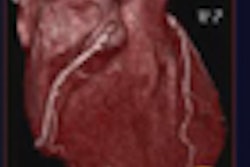Despite frequent colonoscopic surveillance, patients whose advanced adenomas had been removed had higher-than-expected rates of colorectal cancer (CRC) at follow-up, according to a new surveillance study that followed patients for more than four years after polypectomy.
Investigators said the study reaffirms that patients with advanced adenomas remain at higher risk, while cautioning that both the cohort size and the number of interval cancers were too small for sweeping conclusions.
"After initial colonoscopy, patients with adenomas are followed with surveillance colonoscopy to identify and remove subsequent adenomas before they progress to CRC," wrote lead author Dr. Robert Schoen and colleagues from the University of Pittsburgh and the National Cancer Institute (NCI) in Bethesda, MD. "However, colonoscopy is not perfect, and interval cancers diagnosed between surveillance examinations may develop" (Gastrointestinal Endoscopy, January 2010, Vol. 71:1, pp. 111-117).
The four-year Polyp Prevention Trial (PPT) preceding the study aimed to examine the effects of low-fat, high-fiber diets on adenoma recurrence. Researchers examined 1,297 participants (67% men; mean age, 65 years) who had at least one tubular or tubulovillous adenoma at initial colonoscopy. Colonoscopy was repeated at one and four years, and the median follow-up was 4.3 years.
There were nine cases of colorectal cancer over 7,626 person-years of observation (PYO), with each PYO consisting of a patient being followed for a year. Despite the frequent follow-ups, colorectal cancer incidence at follow-up was 1.2/1,000 PYO, 64% of the rate expected without surveillance, based to data from Surveillance, Epidemiology, and End Results (SEER) studies (95% CI: 0.28-1.06).
Including all 22 colorectal cancers diagnosed since the beginning of the original PPT trial, colorectal cancer incidence was 74% of the rate expected by SEER data (95% CI: 0.47-1.05), the authors reported.
Nevertheless, the difference between absolute colorectal cancer rates and those expected based on SEER data was not statistically significant.
The authors cautioned that the number of cancers found was too small to conclude that CRC rates post-follow-up would indeed be higher populationwide.
"Our results confirm the need for continued colonoscopy surveillance in at-risk subjects because of the ongoing risk of CRC and especially among those with a history of advanced adenoma," the authors wrote.
"And we must be sure that a polyp, especially if it is an advanced adenoma, is completely removed, since cancer may develop subsequently at that site if residual tissue remains," said Schoen in an accompanying statement.
By Eric Barnes
AuntMinnie.com staff writer
January 8, 2010
Related Reading
Outpatient colonoscopy safe; risk of complications low, January 1, 2010
Colonoscopy does not reduce right-sided advanced neoplasms, December 31, 2009
CAD catches most flat polyps on virtual colonoscopy, December 16, 2009
Risks from colonoscopy in elderly increase with age, comorbidities, July 13, 2009
Model finds small polyp surveillance safe, cost-effective, November 4, 2008
Copyright © 2010 AuntMinnie.com




















